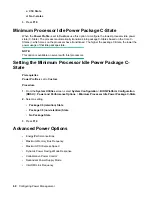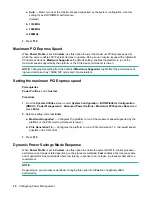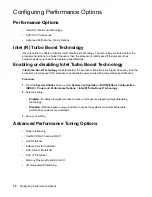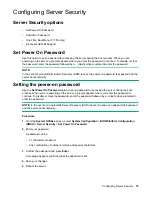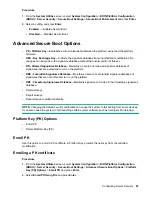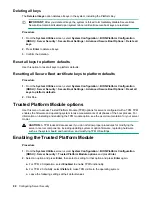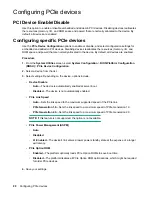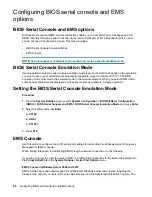
and that the signature is validated against a set of trusted certificates embedded in the UEFI BIOS.
Secure Boot validates the software identity of the following components in the boot process:
• UEFI drivers loaded from PCIe cards
• UEFI drivers loaded from mass storage devices
• Preboot UEFI Shell applications
• OS UEFI boot loaders
When Secure Boot is enabled:
• Firmware components and operating systems with boot loaders must have an appropriate digital
signature to execute during the boot process.
• Operating systems must support Secure Boot and have an EFI boot loader signed with one of the
authorized keys to boot. For more information about supported operating systems, see the UEFI
System Utilities and Shell Release Notes on the Hewlett Packard Enterprise website (
www.hpe.com/info/ProLiantUEFI/docs.
You can customize the certificates embedded in the UEFI BIOS by adding or removing your own
certificates, either from a management console directly attached to the server, or by remotely connecting
to the server using the iLO Remote Console.
You can configure Secure Boot using:
• The
System Utilities
options described in the following sections.
• The RESTful API. For more information, see the Hewlett Packard Enterprise website (
You can use the
secboot
command in the Embedded UEFI Shell to display Secure Boot databases,
keys, and security reports.
Before you enable Secure Boot, make sure you:
Enable
UEFI Optimized Boot
.
Secure Boot Settings
• Secure Boot Enforcement
• Advanced Secure Boot Options
Secure Boot Enforcement
Use this setting to enable or disable Secure Boot.
Enabling or disabling Secure Boot
Prerequisites
Enable UEFI Optimized Boot.
82
Configuring Server Security
Содержание ProLiant m510
Страница 73: ... Gen 1 Speed Gen 2 Speed 3 Save your setting Configuring Power Management 73 ...
Страница 111: ...Scripted configuration flows Scripted configuration flows 111 ...
Страница 113: ...Troubleshooting Troubleshooting 113 ...
Страница 120: ...Support 120 Support ...

